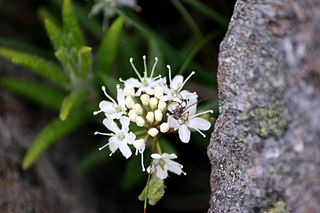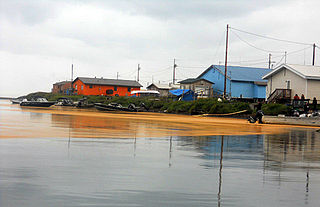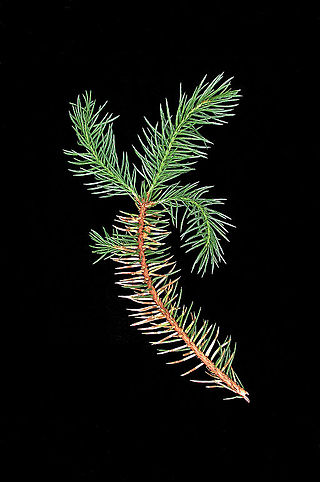
The Labrador Sea is an arm of the North Atlantic Ocean between the Labrador Peninsula and Greenland. The sea is flanked by continental shelves to the southwest, northwest, and northeast. It connects to the north with Baffin Bay through the Davis Strait. It is a marginal sea of the Atlantic.

Labrador tea is a common name for three closely related plant species in the genus Rhododendron as well as a herbal tea made from their leaves.

St. Anthony is a town on the northern reaches of the Great Northern Peninsula of the Canadian province of Newfoundland and Labrador. St. Anthony serves as a main service centre for northern Newfoundland and southern Labrador. St. Anthony had a population of 2,180 in 2021, compared with 2,258 in 2016, 2,418 in 2011, 2,476 in 2006 and 2,730 in 2001.

Chrysomyxa ledi var. rhododendri is a plant pathogen responsible for the disease spruce needle rust.

Chrysomyxa is a genus of rust fungi in the family Coleosporiaceae. The genus, widespread in the Northern Hemisphere, contains about 23 species. Rust fungi in the genus Chrysomyxa occur in boreal forests of the northern hemisphere on Pinaceae,, and most species alternate to angiosperm hosts in the Ericaceae.
Diaphanopellis is a genus of rust fungi in the family Coleosporiaceae. Reported as new to science in 2005, the genus is monotypic, containing the single species Diaphanopellis forrestii, found growing on Rhododendron selense subsp. selense, in the Himalayas.

Chrysomyxa ledicola is a plant pathogen responsible for the disease large-spored spruce-Labrador tea rust. It affects white spruce, black spruce, Sitka spruce, Engelmann spruce, and Labrador-tea. It is also the cause of the orange goo that covered the Iñupiat village of Kivalina, Alaska in the summer of 2011.
Chrysomyxa abietis, or spruce needle rust, is a species of rust fungi in the Coleosporiaceae family that is native to eastern Europe and northern Asia. It was introduced to Australia, New Zealand and the United States.
Chrysomyxa himalensis, is a species of rust fungi in the Coleosporiaceae family that can be found on Rhododendron and Picea species in the Himalayan region of southern Asia and was introduced in the United States.
Chrysomyxa pyrolae, is a species of rust fungi in the family Coleosporiaceae that can be found in such US states such as Alabama, Colorado, Maine and Vermont.
Chrysomyxa succinea is a species of rust fungus in the family Coleosporiaceae which was introduced to Japan where it feeds on Rhododendron dilatatum. The species were recorded from mountains such as Fuji Gotenniwa, Fuji Oniwa and the Yatsugatake Mountains.

Rhododendron columbianum, commonly known as western Labrador tea, swamp tea, or muskeg tea, is a shrub that is widespread in the western United States and in western Canada, reported from British Columbia, Alberta, Washington, Oregon, Idaho, California, Montana, Wyoming, Utah, Nevada, and Colorado. It grows in wet places from sea level up to 3,500 m (11,000 ft). It was formerly known as Ledum columbianum. Its origins date back to the late Pliocene.
Ian Edwin Lawman Hollands Rusted was a Canadian doctor in Newfoundland and Labrador.
Spruce broom rust or yellow witches' broom rust is a fungal plant disease caused by the basidiomycete fungus known as Chrysomyxa arctostaphyli. It occurs exclusively in North America, with the most concentrated outbreaks occurring in northern Arizona and southern Colorado on blue and Engelmann spruce, as well as in Alaska on black and white spruce. This disease alternates its life cycle between two hosts, with the spruce serving as the primary host and bearberry serving as the secondary or alternate host. The name for the disease comes from the distinctive “witches broom”, commonly yellow in color, which forms on the spruce after young needles have been infected. Management must be carried out through physical or mechanical methods, such as the pruning of brooms or the removal of the secondary host from the area, because no chemical control measures have yet been determined to be economically effective. Generally, spruce broom rust is seen as a mostly cosmetic issue, and it is very rarely the direct cause of tree death; however, research has shown a reduction in overall productivity and health of infected trees, making it an important issue for logging and timber companies.

Chrysomyxa weirii, is a fungus that causes a disease, commonly known as Weir's cushion rust, of spruce trees. It is mostly a cosmetic problem, causing yellowish spotting and banding on spruce needles, but in some cases can cause severe premature defoliation. Weir’s cushion rust can also disfigure and reduce growth of spruce trees by targeting the tender needles of newly emerging shoots. This pathogen's spores are spread by wind and water splash and germinate to infect newly developing needles on the same spruce, or neighboring spruce trees. Unlike many other rust disease pathogens, C. weirii is autoecious, only infecting spruce trees. C. weirii is also microcyclic, producing only two of the five possible spore stages common in rust fungi. Trees affected by Weir's cushion rust usually have obvious symptoms, but if treated correctly, the disease can be managed.
Chrysomyxa cassandrae is a fungus that occurs throughout the North Temperate Zone wherever Chamaedaphne calyculata occurs, independent of host alternation. Aecial hosts include white spruce.

Chrysomyxa ledi is a fungus. It occurs in Eurasia throughout the range of its broad-leaved hosts. The aecial stage is found on native and exotic spruces in Europe, including white and Engelmann spruces.
Chrysomyxa neoglandulosi is a fungus. It likely occurs wherever its telial host, Ledum glandulosum Nutt., is found. The only reported aecial host, Engelmann spruce, occurs in montane to subalpine areas in western Canada and the United States.
Chrysomyxa reticulata has been found on Ledum decumbens and Ledum groenlandicum in both eastern and western Canada, as well as Wisconsin, Washington, and California, in the United States, but the aecia are so far known only from artificial inoculation of white spruce.
The spruce cone rust, caused by the rust fungus Chrysomyxa pirolata Wint., affects spruces in 3 continents, including white spruce in Canada. Alternate hosts of the fungus are several species among 3 genera of wintergreen: Pyrola spp., Orthilia spp., and Moneses spp.. Diseased cones open prematurely and orange-yellow aeciospores are sometimes produced in such quantity as to color the forest floor and lake surfaces. Up to half of a cone crop can be affected, and most of the affected cones do not produce viable seed. Some localities commonly experience damage to 20% to 30% of cone crops, a factor to be considered in the siting of seed orchards.







